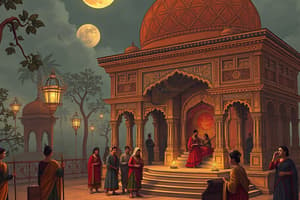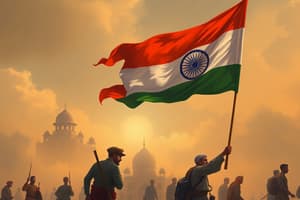Podcast
Questions and Answers
What was the primary objective of the Quit India Movement?
What was the primary objective of the Quit India Movement?
- To support the British efforts in World War II
- To negotiate better terms with the British government
- To demand immediate withdrawal of British rule (correct)
- To promote the economic interests of Indian farmers
Which prominent leader called for non-violent resistance during the Quit India Movement?
Which prominent leader called for non-violent resistance during the Quit India Movement?
- Mahatma Gandhi (correct)
- Sardar Vallabhbhai Patel
- Jawaharlal Nehru
- B.R. Ambedkar
What was a significant factor that triggered the Quit India Movement?
What was a significant factor that triggered the Quit India Movement?
- The success of the Cripps Mission
- Dissatisfaction with British policies (correct)
- Expansion of World War II into Asia
- Formation of the Indian National Congress
What slogan was famously associated with the launch of the Quit India Movement?
What slogan was famously associated with the launch of the Quit India Movement?
How did the British government respond to the Quit India Movement?
How did the British government respond to the Quit India Movement?
Which of the following groups actively participated in the Quit India Movement?
Which of the following groups actively participated in the Quit India Movement?
What was a significant outcome of the Quit India Movement despite its suppression?
What was a significant outcome of the Quit India Movement despite its suppression?
What legacy did the Quit India Movement leave behind?
What legacy did the Quit India Movement leave behind?
Flashcards are hidden until you start studying
Study Notes
Quit India Movement 1942
-
Overview: A mass protest demanding an end to British rule in India, launched by the Indian National Congress on August 8, 1942.
-
Key Figures:
- Mahatma Gandhi: Leader of the movement, called for non-violent resistance.
- Jawaharlal Nehru: Prominent leader within the Congress party.
- Sardar Vallabhbhai Patel: Influential in mobilizing support.
-
Background:
- Triggered by dissatisfaction with British policies and the failure of the Cripps Mission, which aimed to secure Indian support during World War II.
-
Key Objectives:
- Immediate withdrawal of British rule from India.
- Establishment of self-governance and independence.
-
Major Events:
- Launch of the movement in Bombay on August 8, 1942, with the slogan "Do or Die."
- Widespread protests and strikes across the country.
- Arrest of key leaders, including Gandhi and Nehru, leading to decentralized leadership.
-
Methods of Protest:
- Nonviolent civil disobedience: Boycotts, strikes, and demonstrations.
- Mass mobilization of citizens, including students, workers, and peasants.
-
Government Response:
- Brutal repression: Arrests, censorship, and violence against protestors.
- Declaration of the movement as a "rebellion" by British authorities.
-
Significance:
- Marked a turning point in the Indian independence struggle.
- Increased unity among different Indian factions against colonial rule.
- Highlighted the determination of Indians to achieve self-rule, despite severe repression.
-
Aftermath:
- The movement was suppressed, but it caused a significant shift in British attitudes toward India.
- Laid the groundwork for post-war negotiations for independence.
-
Legacy:
- The Quit India Movement is remembered as a symbol of the fight for freedom in India.
- Reinforced the idea of civil disobedience as a powerful tool for social and political change.
Overview
- Mass protest initiated by Indian National Congress on August 8, 1942, demanding an end to British rule in India.
Key Figures
- Mahatma Gandhi: Led the movement advocating for non-violent resistance.
- Jawaharlal Nehru: Significant leader within the Congress party, actively involved in the movement.
- Sardar Vallabhbhai Patel: Played a crucial role in mobilizing widespread support.
Background
- Movement was fueled by Indian dissatisfaction with British policies.
- The failure of the Cripps Mission to secure Indian cooperation during World War II intensified calls for independence.
Key Objectives
- Immediate withdrawal of British rule from India.
- Establishment of self-governance and full independence for India.
Major Events
- The movement was officially launched in Bombay with the rallying cry "Do or Die."
- Triggered widespread protests and strikes across various regions in India.
- Key leaders, including Gandhi and Nehru, were arrested, leading to a breakdown into decentralized leadership structures.
Methods of Protest
- Employed nonviolent civil disobedience, including boycotts, strikes, and public demonstrations.
- Successfully mobilized diverse groups such as students, workers, and peasants to participate in the protests.
Government Response
- British authorities responded with severe repression, including arrests and censorship.
- Declared the Quit India Movement as a "rebellion" to legitimize their violent suppression against protestors.
Significance
- Represented a pivotal moment in the Indian independence struggle, uniting various factions against colonial rule.
- Demonstrated the resolve of the Indian populace to attain self-rule, regardless of backlash and repression.
Aftermath
- Although the movement was ultimately suppressed, it shifted British perspectives on managing India.
- Set the stage for future negotiations on Indian independence following World War II.
Legacy
- The Quit India Movement is celebrated as a hallmark of India's fight for freedom.
- Reinforced civil disobedience as a compelling method for attaining social and political change.
Studying That Suits You
Use AI to generate personalized quizzes and flashcards to suit your learning preferences.



